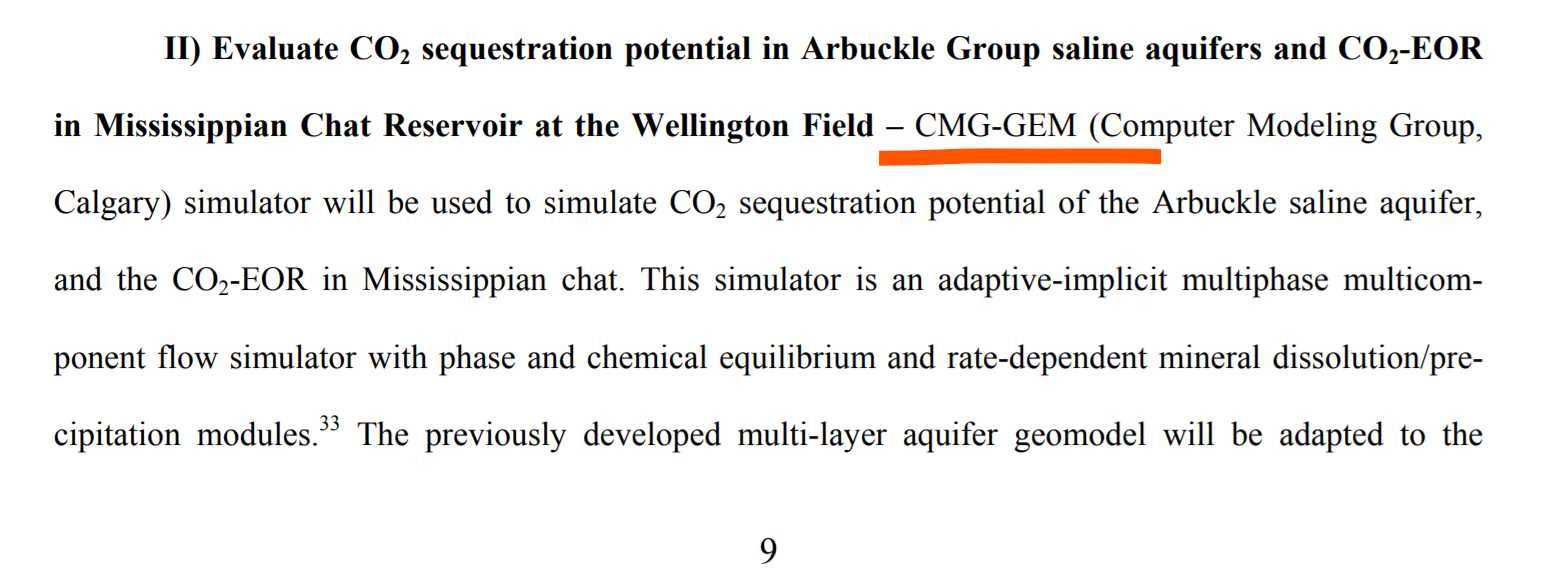Modeling CO2 Sequestration in Saline Aquifer and Depleted Oil Reservoir to Evaluate Regional CO2 Sequestration Potential of Ozark Plateau Aquifer System, South-Central Kansas
ABSTRACT
The proposed study “Modeling CO2 Sequestration in Saline Aquifer and Depleted Oil Reservoir to Evaluate Regional CO2 Sequestration Potential of Ozark Plateau Aquifer System, South-Central Kansas” is focused on the Paleozoic-age Ozark Plateau Aquifer System (OPAS) in south-central Kansas. PI’s on this project are Saibal Bhattacharya and W. Lynn Watney, both with the Kansas Geological Survey (KGS) (University of Kansas), Lawrence, KS. OPAS is comprised of the thick and deeply buried Arbuckle Group saline aquifer and the overlying Mississippian carbonates that contain large oil and gas reservoirs. The Arbuckle Group consists of porous dolomitic carbonates with interbedded shaly aquitards. The OPAS in south-central Kansas is well suited for super-critical CO2 sequestration in deep saline aquifers because of its depth (>3500 ft), thickness (>800 ft), and isolation from the shallow freshwater aquifers by regional caprock, the Chattanooga Shale (thickness ≈ 50 ft). Another caprock of lower Pennsylvanian shales overlie the Mississippian carbonates (thicknesses in 10’s of ft). The OPAS in southcentral Kansas is centrally located to multiple major point sources of CO2 emissions. Demonstration of significant CO2-EOR will motivate field operators to consider infrastructure buildup necessary to CO2 injection in their depleted oil fields. This infrastructure can also be used for commercial scale CO2 sequestration in the underlying Arbuckle Group saline aquifers.
Published estimates of CO2 sequestration capacity in the Arbuckle Group in Kansas vary between 1.1 to 3.8 billion metric tones based on static CO2 solubility in brine under in situ pressure and temperature. However, injected CO2 and its solubility in brine triggers a dynamic in situ convection which aided by background aquifer velocity brings new unsaturated brine (from depth) to increase CO2 sequestration. Significant and comparable tonnage of CO2 can be additionally sequestered as residual gas saturation and some more by long-term mineralization in saline aquifers. In addition to sequestration capacity of the Arbuckle Group saline aquifer, the Mississippian Wellington Field is estimated to hold ~25 million metric tonnes of CO2 thus underscoring the importance and timeliness of evaluating the sequestration potential of this large CO2-sink in Kansas.
The proposed study, a collaboration between the KGS, Kansas State University, BEREXCO, INC., Bittersweet Energy, Inc. (Wichita, KS), will focus on the Wellington Field, Sumner County, Kansas, and integrate seismic, geologic, and engineering approaches to evaluate miscible CO2-EOR and tertiary oil recovery potential in the Mississippian chat reservoir and CO2 sequestration potential in the underlying Arbuckle Group saline aquifer. The proposed study will also develop a larger Arbuckle Group (saline) aquifer geomodel over a 17+-county area (centered on the Sedgwick Basin) in south-central Kansas and estimate regional CO2 sequestration potential. The key scientific theme is to understand the geologic fundamentals behind the internal stratal architecture, structural deformation, and diagenesis and to evaluate their role on flow units, cap rock integrity, aquifer storage, and identification of reservoir compartments and barriers to flow. A 10 mi2 3D seismic survey along with two new wells will be drilled (to the Precambrian basement) in the Wellington Field. The geophysical data including high resolution gravity/magnetics survey will be analyzed to characterize fracture/faults and compartments from the basement up through the overlying strata. One of the new wells will be cored from the Mississippian cap rock to the basement and special core analysis undertaken to determine facies-specific petrophysics. Modern logs (including CMR and FMI) will be run in both wells. High injectivity zones will be tested to determine aquifer/aquitard-specific geochemistry. Ultimately, reservoir simulation studies will be carried out in CMG-GEM to determine CO2 injectivity in aquifers, tonnage of CO2 sequestered in solution, residual gas saturation, and mineral precipitates. It will evaluate seal integrity in overcoming pressure increase upon injection, seal porosity changes due to geochemical reactions, and estimate CO2 leakage as fraction of injection. Near- and long-term simulations will be carried out to quantify free phase CO2, its distribution, and time for its dissipation, to understand plume growth, its area of influence and attenuation in presence of multiple aquitards and background aquifer flow, and movement in contact with fault zones. Detailed risk analysis studies will be conducted with FEHM simulator to estimate CO2 leakage (injection fraction) as a result of cement degradation in existing wells. Successful completion of this “shovel ready” project will bring a confluence between commercial interests and sequestration viability leading to the establishment of a new “green” CO2-sequestration industry in the Midwest.
堪萨斯州地质调查局


